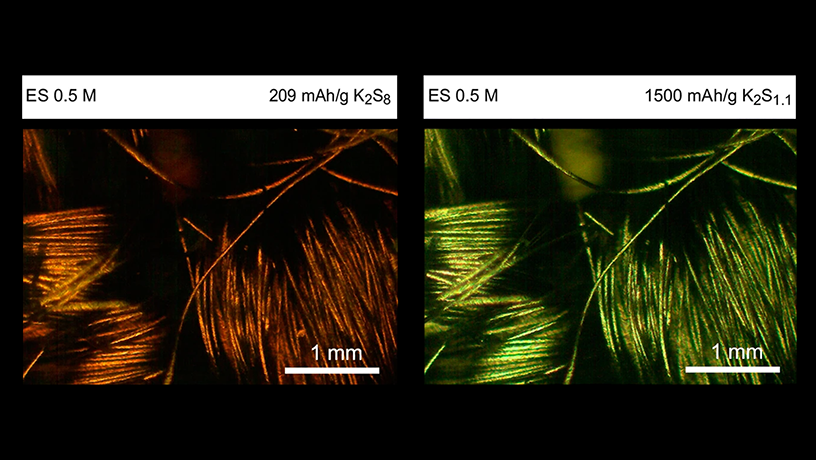Reviewed by Lexie CornerSep 17 2024
Material scientists at Columbia Engineering created a novel battery type that will revolutionize renewable energy storage. In a recent study published in Nature Communications, the researchers utilized K-Na/S batteries, which combine sulfur (S), potassium (K), and sodium (Na)—three abundant and low-cost elements—to create a high-energy, cost-effective solution for long-duration energy storage.
 Optical microscope imaging of catholyte at room temperature, showing that no solid is formed at the end of discharge (right figure). The coiled carbon fibers, which are the current collector (substrate) for the catholyte, are visible. The two images show the catholyte’s color change during battery discharge. Image Credit: Yuan Yang lab
Optical microscope imaging of catholyte at room temperature, showing that no solid is formed at the end of discharge (right figure). The coiled carbon fibers, which are the current collector (substrate) for the catholyte, are visible. The two images show the catholyte’s color change during battery discharge. Image Credit: Yuan Yang lab
Although renewable energy sources like solar and wind power are crucial for sustaining the planet, they have a major limitation: they do not always generate electricity when needed. To maximize their potential, one must develop cost-effective and efficient methods to store the energy they produce, ensuring a reliable power supply even when the sun is not shining or the wind is not blowing.
It is important that we be able to extend the length of time these batteries can operate and that we can manufacture them easily and cheaply. Making renewable energy more reliable will help stabilize our energy grids, reduce our dependence on fossil fuels, and support a more sustainable energy future for all of us.
Yuan Yang, Associate Professor and Team Leader, Department of Applied Physics and Mathematics, Columbia Engineering
New Electrolyte Helps K-Na/S Batteries Store and Release Energy More Efficiently
K-Na/S batteries face two major challenges: low capacity due to the formation of inactive solid K₂S₂ and K₂S, which block the diffusion process, and the need for very high operating temperatures (>250°C), which complicates thermal management and raises costs.
Previous research has struggled with these issues, prompting the search for new methods to improve battery performance. Yang's team developed a novel electrolyte using an acetamide and ε-caprolactam solvent to enhance the battery's energy storage and release. This electrolyte helps dissolve K₂S₂ and K₂S, improving the energy density and power density of K/S batteries operating at intermediate temperatures.
Additionally, this design allows the battery to operate at a much lower temperature (around 75 °C) while still approaching its maximum potential energy storage capacity, a significant improvement over previous designs.
Our approach achieves nearly theoretical discharge capacities and extended cycle life. This is very exciting in the field of intermediate-temperature K/S batteries.
Zhenghao Yang, Study Co-First Author, Columbia Engineering
Pathway to a Sustainable Energy Future
Yang's team is part of the Columbia Electrochemical Energy Center (CEEC), an organization that uses a multiscale approach to discover new technologies and accelerate their commercialization.
CEEC brings together faculty and researchers from the School of Engineering and Applied Science who are focused on electrochemical energy. Their interests range from electrons to devices and systems. CEEC's industrial partnerships play a crucial role in achieving advancements in electrochemical energy storage and conversion.
Planning To Scale Up
Although the team is currently focusing on small, coin-sized batteries, they aim to eventually scale up the technology to store large amounts of energy. If successful, these new batteries could provide a stable and reliable power supply from renewable sources, even when wind or sunlight is limited. At present, the group is focused on optimizing the electrolyte for improved performance.
Journal Reference:
Tian, L., et al. (2024). Designing electrolytes with high solubility of sulfides/disulfides for high-energy-density and low-cost K-Na/S batteries. Nature Communications. doi.org/10.1038/s41467-024-51905-6.